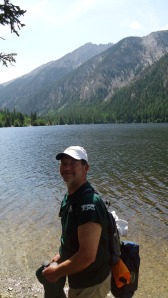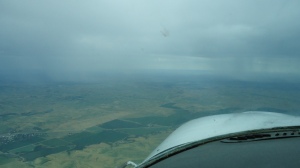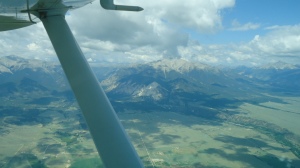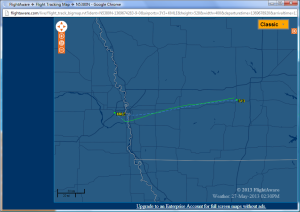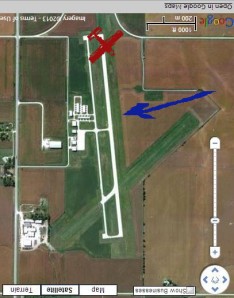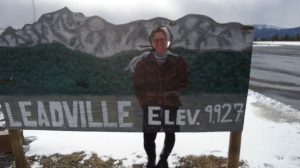For a while, I’ve been interested in what causes fear and why sometimes I don’t go after opportunities because of fear. I’ve been reading “IN A PIT WITH A LION ON A SNOWY DAY” and just read something that made me perk up. This book is about facing fears when opportunity knocks. It says, “…the alternative to fear is boredom….” And God didn’t make us to be bored. If we’re bored, we’re refusing to be who he made us to be. I had never looked at boredom that way before and will certainly keep that in mind if I start feeling bored in my role as a husband or father, a professional, or follower of Christ.
Victory
I read this poem today, written by Hubert Kauffman. I reflected upon the goals I’d set this year and last year; the ideas I’d had and the progress I made. The only person who ever stops me… is me! What an motivation to make the most of the time God gave us!
VICTORY
You are the man who used to boast
That you’d achieve the utttermost,
Some day.
______________________________________
You merely wished a show,
To demonstrate how much you know
And prove the distance you can go…
______________________________________
Another year we’ve just passed through.
What new ideas came to you?
How many big things did you do?
______________________________________
Time… left twelve fresh months in your care.
How many of them did you share
With opportunity and dare
Again where you so often missed?
______________________________________
We do not find you on the list of Makers God.
Explain that fact!
Ah no, ’twas not the chance you lacked!
As usual – you failed to act!
Summer Adventure to Leadville (KLXV)
One of my dreams over the past couple of years was to fly to Leadville, Colorado, home of the highest municipal airport in North America (KLXV). It sits in a high mountain valley at 9934 feet above sea level. A fantastic opportunity opened up for me this summer to attend a men’s retreat with the Band of Brothers USA. This is a 5 day camping trip with about 150 men where we ventured out on mountain biking expeditions, white water rafting trips, ATV or Jeep tours, go fishing, or just about anything else you could think of. Most importantly, we strengthened our bond with each other and with our King, Jesus Christ. Men, if you want to have the time of your life with men of God, this is the way to go. I decided that this year that I would fly up to Leadville. I mentioned the idea of flying there to Bill Buermann, a good friend of mine from church, and he loved the idea. So we were set on that plan.
Since I had never flown in the mountains, and since it is such a different experience that flying in the flatland of Iowa and Nebraska, I wanted to beef up with some training. I contacted a friend, Will, from Cañon City, CO who operates Royal Gorge Helitours (check them out if you’re in the area) and he offered to take me through a four hour course on the ups and downs, ins and outs of flying through mountainous terrain. With that done, I felt a lot better about taking on this challenge.
Our day finally arrived and we flew out of Omaha, Nebraska from the Millard Airport in the Skyhawk Flying Club’s Cessna 182Q, direct to Pueblo. The trip to Pueblo took a bit longer than expected, as I needed to route around some thunderstorms.
From Pueblo, we flew to Cañon City, through Monarch Pass, then climbed to 12,200 feet and direct to Leadville. Not only was this my first trip flying in the mountains, it was also my first time flying a general aviation craft at that altitude. After 15 minutes or so, I was starting to feel the effects of the shortage of oxygen. Luckily, the time between Buena Vista and Leadville was only about 20 minutes so altitude wasn’t going to be a big problem. By the way, the views from the plane flying through the mountains were absolutely incredible!
Since the air is thinner at that altitude, I knew that my approach to landing would feel faster than landing at Millard. The plane has to move faster through the air to produce enough lift to stay airborne. The engine doesn’t have as much power either. I was prepared for all this but it still felt very different when landing. I’ve posted a video of the landing, from downwind, to base, final approach, touchdown and the taxi to the terminal.
This was such an amazing adventure. If you’re a pilot, the first time you do this, they’ll give you a “Certificate of Navigation,” which is now framed and hanging up in our bedroom. Next time, I’ve got take Laura with me! She will love it.
Flying with Friends
This morning my wife, Laura, and daugher, Elyssa, and I got up and drove to Tarkio, Missouri, land of some of the most interesting roads I’ve ever seen.

Our purpose for this 88 mile drive was to attend the 10th Annual Wing Nuts Flying Circus!
 I received a flyer in the mail a couple weeks ago that advertised fun and adventure for aviation enthusiasts. Count me in! My wife and I have made a couple of trips there over the past couple of years. On our first flight to Tarkio (Gould Peterson Memorial Airport – K57), we met a guy named Sam Graves, and he showed us around the airfield. There wasn’t anything extraordinary about the airfield, other than a guy who seemed deeply in love with aviation. He showed us a hangar that had two military trainers, which were amazing. Then he took us to the upper level of the hangar, where he told us the local flying club met regularly. It had a nice bar-like set up. Off the top upper level of the hangar was a large deck, and what looked like an air traffic control tower.
I received a flyer in the mail a couple weeks ago that advertised fun and adventure for aviation enthusiasts. Count me in! My wife and I have made a couple of trips there over the past couple of years. On our first flight to Tarkio (Gould Peterson Memorial Airport – K57), we met a guy named Sam Graves, and he showed us around the airfield. There wasn’t anything extraordinary about the airfield, other than a guy who seemed deeply in love with aviation. He showed us a hangar that had two military trainers, which were amazing. Then he took us to the upper level of the hangar, where he told us the local flying club met regularly. It had a nice bar-like set up. Off the top upper level of the hangar was a large deck, and what looked like an air traffic control tower. 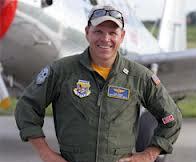 He told us that the tower used to be at Offut Air Force Base. Laura and I climbed the tower and looked out. It was quite a novelty. Later, he gave us an invitation to come back down to visit them when they have their air show.
He told us that the tower used to be at Offut Air Force Base. Laura and I climbed the tower and looked out. It was quite a novelty. Later, he gave us an invitation to come back down to visit them when they have their air show.
My first desire was to fly to the event but in the end, I opted to drive. Trust me; flying there is easier than driving there. By the time we got there, police and the EMS had blocked off the main drive to the air field, which runs along side of the runway so we had to find a back way in. Laura, Elyssa and I took all kinds of paths. One dirt road we took ended at a river with no bridge across. The dirt road was for one lane only and was over-grown with grass so we had to back the car out in reverse for at least ½ a mile. Someone else had the same bright idea that we had so there were two cars backing out of this wonderful road. To say the road was minimum maintenance would be a stretch. On to a different set of paths and 45 minutes after we arrived at Tarkio, we made it to the air field. What an adventure.
Nonetheless, once we arrived, I was really glad we came down. Before coming down to Tarkio, I had coordinated with Darren Koehn, a feller Skyhawk Flying Club member, to meet at the show. Darren and I have flown together on a couple of occasions; he was my safety pilot as I worked on my instrument rating. It was nice to see a familiar face when we were looking at the rows of planes that attendees had flown in. We had a nice conversation then we parted ways.
While looking at the many planes that were flown down to the show, I saw a bright orange bi-plane that piqued my interest. Sitting behind the tail of the plan was the apparent owner. I asked if I could peek inside. After giving his approval, he stopped over and introduced himself as Greg Schildberg from Greenfield, IA. I know Schildbergs of Greenfield as they operate several rock quarries across Iowa. It was great to meet him and to check out his Meyer bi-plane. He is an aviation enthusiast and the president of the Iowa Aviation Museum in Greenfield, IA. It’s a very neat exhibit if you ever get the chance to see it.
Dennis Oliver was another man I met who was resting in the back seat of a Super Decathlon, which is a tandem aerobatic plane. He’s a farmer from Williamsurg, IA. I suspect he’s done very well in his career as a farmer as he’s got two other planes at home and a 4000 ft. runway to go with them. He also told me that he raises camels. In writing this posting, I did a little background check on him and found out that in 1980, he set a Guinness World Record with the most take-offs and landings in one day, 138!
Some childhood memorys came to light when I saw Glen and Linda Anderson from Winterset, IA. I grew up with their son, Brad Little. They fly a Cessna 172 based in Creston, IA. We chatted about life and flying and just caught up since the last time we ran into each other.
Laura, Elyssa and I took pictures of planes, enjoyed some brats, and then headed back for home. Did I mention that there was an airshow?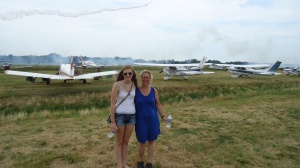 Well, there was a fantastic show which we enjoyed immensely. But frankly, even more than watching the airshow, I enjoyed the camaraderie that fellow pilots share in their love for planes. Get out and do something that you love. I’m always amazed by the friendships I’ve formed and the people I’ve met. What an adventure!
Well, there was a fantastic show which we enjoyed immensely. But frankly, even more than watching the airshow, I enjoyed the camaraderie that fellow pilots share in their love for planes. Get out and do something that you love. I’m always amazed by the friendships I’ve formed and the people I’ve met. What an adventure!
Flying in circles
What happens when you blindfold someone and then ask them to walk in a straight line? Exactly the opposite thing. To see what I mean, have a look at NPR’s blog post on the matter. There have been several studies on the matter and only in situations where the blindfolded subject can feel the sun’s rays on them, could a straight line been maintained (see the yellow line in the picture below).
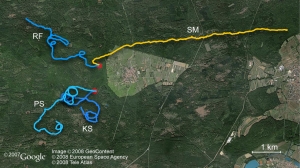
This is what I was thinking about last weekend when Laura and I were trying out my newly earned instrument rating by flying to my parents hometown (Winterset, IA) some 100 miles from Omaha. We’ve been dealing with what feels like several weeks of clouds and rain, which are perfect for instrument flying, as long as there are no thunderstorms. I’ve heard that thunderstorms are a thrill you may only experience once.
When we took off from Millard (KMLE), I could see a thick layer of clouds ahead of me. It wasn’t long and we were flying into a thick blanket of fluffiness. In following minutes, transitioning from seeing the ground out my window to seeing nothing but the inside of a pillow out my window, I realized that this is the same feeling as the blindfolded subjects experience when trying to walk a straight line.
Until I got into the grove of things, it was a bit topsy-turvy in the ol’ Cessna 182. Keeping a close eye on my turn coordinator, what my body was telling me was straight and level flight was actually about a 30 degree bank to the right. Surely without my gauges, my wife and I would have soon been spiraling to the ground.
We all need something to keep us going in the right direction. For the blindfolded subjects, traveling on two feet, it’s the sun beating against their left or right side that helps them keep a straight line. For pilots flying through clouds, it’s the compass, turn coordinator, and the artificial horizon indicator that guide us.
It got me thinking about life in general. What guides us? Where does our direction come from? I’ve learned that I need to rely on Jesus’ guidance and his word. Psalm 119:105 in the Bible says, “Your word is a lamp for my feet, a light on my path.”
For me, I have a tendency to start veering off to the left or to the right without even realizing it. I’ve set goals of where I want to be but then abandoned them for an easier path. Or worse yet, I’ve had times where I haven’t even given much thought to where God wants me to be or what he wants me to do and just went wherever the wind blew me.
I don’t know what my immediate future holds but I do know that because he sent his Son to die for my shortcomings, failures and misguided attempts to direct my own path, I’m going to be with him when I die. Having God’s word as a guide gives me direction on how I should be flying this earthly vessel. I just want you all to know about what Jesus did for you. No matter what spiraled path you’ve taken or how many times you’ve gotten lost in the clouds, Jesus is seeking you out and wants to show you a way out.
Laura and I finished our flight last weekend having flown the entire route through a cloud layer. Thankfully, all systems worked properly and it wasn’t long that we descended through the clouds when Laura said that she could see the light runway. Shortly after landing, as we were unloading the plane, I heard thunder in the distance. What a relief that was that we made it to the ground safely!
Death is in the Air (Not really)
“Did you hear about that plane crash last week?” or “ I had a friend who died in a plane crash a few years ago.” Inevitably, nearly every flying-related conversation with a non-pilot turns to plane accidents.
I’d heard for years that flying is safer than driving a car but had never really looked into it before. So, using the Googler, I found an article about aviation safety in comparison to auto safety written by USA Today. Did you know that in 2008, there were only 1.27 fatalities per 500 million miles flown? The National Safety Council calculated the odds of dying in a car to be 1 in 98 for a lifetime. The odds of dying in a plane were 1 in 7,178!
Nevertheless, people remember plane accidents. Ironically, I know two people in the past three years who have died in plane accidents. Both cases appear to be errors in judgement that lead to the crashes. One flew into low clouds, during rain, and at night without the proper training to do so. The other I suspect crashed while flying very close to the ground and snagged a power line. I have heard that the most frequent causes of accidents are flying drunk, flying into clouds without training or running out of gas. Once again, these are all completely avoidable.
On the bright side, planes aren’t crashing due to the wings falling off. Planes flown in the U.S. are inspected by a certified aviation mechanic no less than annually. This is done to ensure that they’re functioning as designed. Planes flown in commercial operations are required to be inspected very 50 hours. Even my 1969 Cessna 172 flies like a new one. If anything creating an safety risk is found, it gets repaired or it’s deemed not airworthy by the mechanic and its grounded.
For those who are scared to death to step into a plane, I say get over it! It’s a lot safer than you think and it is an experience that you’ll never forget.
Doing More with Less
I love to fly. I talk about it a lot with my friends, relatives, wife, kids, strangers or anyone who might be interested. Of all the people that I talk about flying with, I enjoy conversations with other pilots. I have friends who have been flying for years and have gone all around the country, to the Caribbean Islands, below the rim of the Grand Canyon (back when you could still do that), up to the highest airport in North America, through mountain passes and landing on muddy grass runways. I also have a lot of friends who love to fly and have taken a couple of lessons as student pilots but have stopped before getting their license. This is why.
Flying is expensive. These are some of the reasons that it costs so much to fly.
- Most small aircraft, such as what I fly, use 100 octane, leaded gasoline with no ethanol. Can that be purchased at your local gas station? No way. All gasoline purchased at a gas station is unleaded and you’re lucky to buy higher than 92 octane around Omaha at about $3.25/gallon currently. We have to use aviation grade gasoline in the plane and it costs around $5.75/gallon. The plane burns about 10 gallons per hour so an hour of flying, just for the gas, approaches $60.00/hr.
- Airplane engines are expensive! Imagine if you blew the engine in your car. You could probably get a brand new engine $3-5k, plus installation costs. If you drive your car 150k miles, the replacement cost is about $2 per hour. For the Cessna 172, plan on spending $30,000, plus installation for a new engine. Plane engines in the Cessna are rated for 1,800 hours. Divide 30k by 1.8k and that’s another $17/hr.
- You can’t park a plane in your home garage (typically). While I realize that some could argue that a plane could be parked in the garage at home, try that on a Cessna 172. Our airport charges around $115/month for hangar space. That’s a cost of $1,380 each year. If you fly 50 hours/year, tack on another $28/hr.
- Insurance ~$1,200 year. At 50 hours flown, add $24/hr.
- Annual inspections are required for all general aviation airplanes. The base cost for that inspection varies but could be $1,200-$1,500. If there’s something wrong with the plane, adjust accordingly. At a minimum, that’s $24/hr.
That’s roughly $153 per hour!! True, if flying more, the fixed costs will decrease but it is still not cheap. I, like many of my dear friends, have a finite amount of money. The only way flying becomes a reality for me is if I can get more flying for the money, reducing my hourly costs. So, how can I get more flying in for the money? Here’s what I’ve done.
- Rent a plane at the local airplane rental facility, knows as the “FBO” or “fixed base operator.” plan on spending around $100 for every hour that the engine is running. That’s still pricey but it sure beats paying $153 per hour.
- Join a flying club. Flying clubs have have as many or as few members as desired but all of the fixed costs such as annual inspections, hangar, insurance, are shared across the club. With my flying club, Skyhawk Flying Club, I only pay $83/hour to fly the Cessna 172. The bigger planes are more, but they’re faster, burn more gas, cost more to maintain, etc.
What do others do? Some of my friends save money in different ways. For example, my friend Lamar purchased a 1947 Luscombe tail-dragger with three partners to share the costs. It runs on non-ethanol car gas! That’s a big savings right there. It also has a smaller engine so the replacement cost on that is somewhere in the $15k range which reduces the hourly maintenance costs. He also assists inspectors who do the annual inspection, which saves around $500. Instead of having the inspector do all the work, he does it instead. All that brings the hourly costs of flying to an even more acceptable rate.
Flying is expensive and I image that there are other things that I could do with my money but there is little that I feel more passionate about. If you feel the same way about it as I do, figure out a way to make it happen. I’ve touched on some ways to reduce the costs of flying but there are others as well. Get creative and make it happen. And if you ever want to go flying with me, let me know and we’ll split the charge! (Oh, another way to reduce the costs.)
Crosswind Landings
Elyssa had a soccer game and I wanted to go see her play. Winds 070 at 12 knots was wind readout when calling the nearest airport (Lincoln). I was 10 miles out of Seward, NE (KSWT) this past Tuesday and I needed to figure out how I was going to land the Cessna. Runway options were 16 and 34. Doing the math, I had the option of landing on either runway. I was getting a 90 degree crosswind at 12 knots either way. The Cessna 172’s limitations are 15 knots demonstrated crosswind component.
Now Seward also has a grass runway which would have much more direct to the wind but it had been raining for three days straight and I had a bad feeling that I could rip the gear off in the mud. Turf landing was out of the question.
So, it’s time to see if I know what I’m doing. There’s a lot of technique that instructors will talk about when landing in crosswind situations and I’m sure they’re all right. Some will say to crab the plane until you’re almost touching down then quickly straighten the plan. Others will say to tip the upwind wing down to counteract the effects of the wind.
For me, it’s always just been a feel. Thinking about one technique or another doesn’t really enter my mind until I’m already on the ground. I just know is that it’s important to keep the plane’s final approach path lined up with the runway. Most of the time, that means I’m crabbing the plane but sometimes, that means I’m tipping the wing. I just do what I need to do to keep the plane’s path straight to the runway.
It’s Thursday now and I didn’t crash the plane so obviously, I had a successful landing, got to watch Elyssa play soccer and live to fly another day. I crabbed the plane down to the run way, but the winds were so strong, I ended up switching to a wing low on the upwind side strategy to get it on the ground. This was a great experience (despite the pucker factor) and appreciated the challenge.
Pilgrimage of a Cessna
I love flying. There are several aviation destinations that I’ve got on my checklist over the next couple of years. One of those involves flying from my home airport, Millard, Nebraska 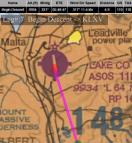 (KMLE), to the highest public airport in North America, Leadville, Colorado (KLXV). This isn’t just a hop, skip and a jump in my Cessna 172 four-seater-but-only-carries-two airplane. No, this trip will require all my skill and everything this little plane has to give. There’s a couple of big reasons that this is such an interesting trip. One, it’s in the mountains and that brings all kinds of different wind changes to be aware of. Two, there are mountains and mountain passes that reach or exceed the altitude capacity of the Cessna.
(KMLE), to the highest public airport in North America, Leadville, Colorado (KLXV). This isn’t just a hop, skip and a jump in my Cessna 172 four-seater-but-only-carries-two airplane. No, this trip will require all my skill and everything this little plane has to give. There’s a couple of big reasons that this is such an interesting trip. One, it’s in the mountains and that brings all kinds of different wind changes to be aware of. Two, there are mountains and mountain passes that reach or exceed the altitude capacity of the Cessna.
Laura and I were in Colorado a couple of weeks ago and visited Leadville airport after skiing at SkiCooper, a smaller yet very friendly little ski resort in Lake County. Side note, if you’re ever in Leadville, check out a restaurant on mainstreet called “Quincy’s,” home of the $8.95 filet minon.
The trip starts bright and early. I’ll have to be up bright and early; 3:00 a.m. should do it. Showered and dressed in hiking pants and a t-shirt, I’m on the phone with 800-WXBRIEF to find out the latest weather patterns and what I’ll expect along my route of flight. The weather briefer will also tell me if there are any flight restrictions to watch out for. While on the phone, I’ll be on the computer pulling up www.aviationweather.gov to check satellite, radar, winds aloft, temperatures and so on. I’ll do double checks on the tablet to make sure that the sectionals, low-enroute and approach charts for airports along the way a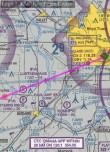 re up-to-date on Fltplan.
re up-to-date on Fltplan.
Laura will be packing some snacks and drinks for the flight and also gathering some emergency supplies. You never know, it is better to be prepared than to be left wanting in the middle of nowhere with engine trouble. All packed up, we’re out the door at 4:00 a.m and heading to the airport.
The sky is still dark when I open the hangar door at 4:15. Laura starts loading our supplies while I do pre-flight checks. In the pre-flight, the lights inside and outside the plane check out. All the connections appear good, nothing is loose that shouldn’t be. The fuel is full, oil sits at 6.5 quarts and we’ve got a spare quart in the back. Laura gets in and buckles up. She’s excited whenever we fly and this is no exception. I pull the plane out and we’re headed out on one great adventure.
The Principle
The principle runs through all life from top to bottom. Give up yourself, and you will find your real self. Lose your life and you will save it. Submit to death, death of your ambitions and favorite wishes every day and death of your whole body in the end: submit with every fiber of your being, and you will find eternal life. Keep back nothing. Nothing that you have not given away will be really yours. Nothing in you that has not died will ever be raised from the dead. Look for yourself, and you will find in the long run only hatred, loneliness, despair, rage, ruin, and decay. But look for Christ and you will find Him and with Him everything else thrown in.
C.S. Lewis
Starting last year, I began a journey with some men from my church, known as the Band of Brothers. In the quest for finding work and adventure that is fulfilling my purpose here on Earth, it’s great to have a group of men to explore and to bond with.
